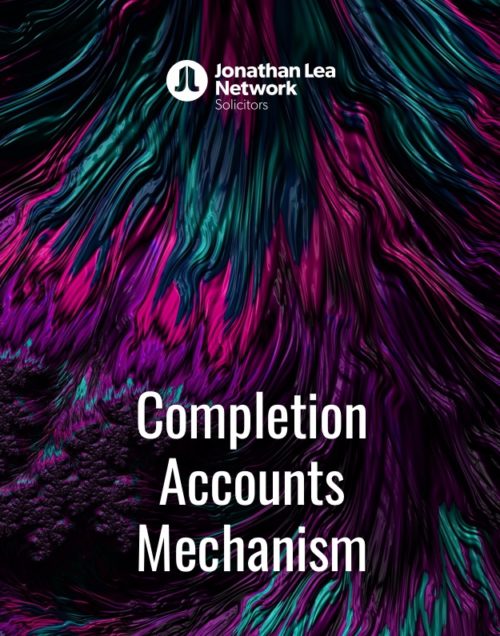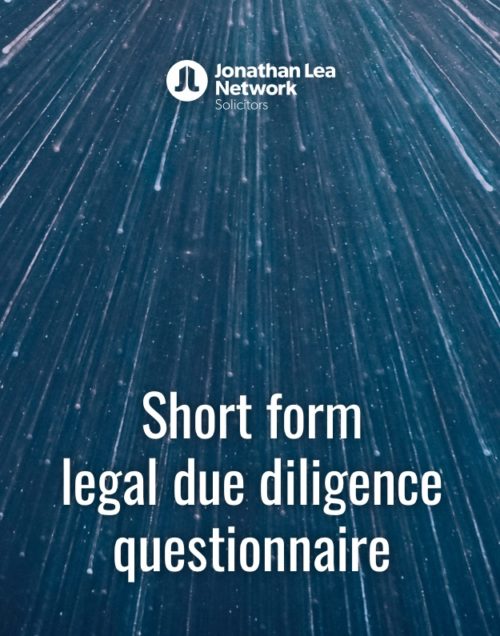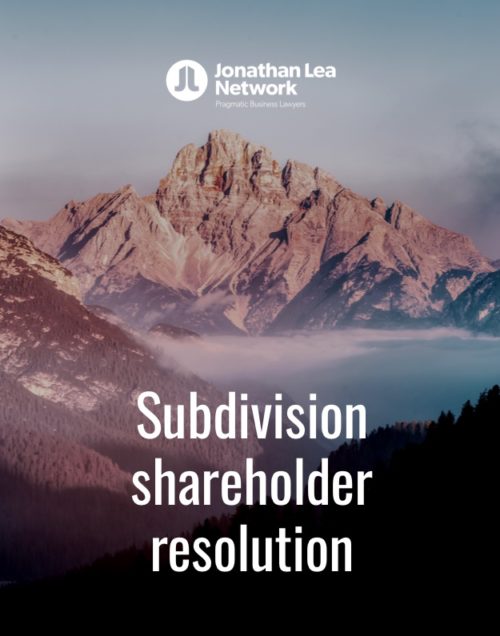Co-Founder Vesting Agreement
£6.99
This template is a simple co-founder vesting agreement, which can be used where the initial shareholder (or founder) of a private company is proposing to either transfer some of their existing shares or issue new shares in the relevant company to a new co-founder. However, rather than receiving all of the shares at once, the shares will be subject to certain provisions whereby the shares will transfer (or vest) over a set period and if, at any time during this vesting period the co-founder ceases to be employed by the company, then the initial shareholder (or founder) will have a right to repurchase any unvested shares.
The purpose of the document is to record the terms under which the shares will vest and the events that will trigger a right to buy-back any unvested shares. It is not intended to cover any of the more general provisions governing the relationship between shareholders, which should be contained within the shareholders agreement.
Due to HMRC’s anti-avoidance rules relating to “employment related securities”, we would recommend obtaining tax advice prior to using or implementing any co-founder vesting arrangements. If this is something that you would like assistance with, please get in touch here.
Drafting Notes – Co-Founder Vesting Agreement
This template is a simple co-founder vesting agreement, which can be used where the initial shareholder (or founder) of a private company is proposing to either transfer some of their existing shares or issue new shares in the relevant company to a new co-founder. However, rather than receiving all of the shares at once, the shares will be subject to certain provisions whereby the shares will transfer (or vest) over a set period and if, at any time during this vesting period the co-founder ceases to be employed by the company, then the initial shareholder (or founder) will have a right to repurchase any unvested shares.
The purpose of the document is to record the terms under which the shares will vest and the events that will trigger a right to buy-back any unvested shares. It is not intended to cover any of the more general provisions governing the relationship between shareholders, which should be contained within the shareholders agreement.
Due to HMRC’s anti-avoidance rules relating to “employment related securities”, we would recommend obtaining tax advice prior to using or implementing any co-founder vesting arrangements. If this is something that you would like assistance with, please get in touch here.
General Drafting Notes
Information which needs to be inserted is highlighted in yellow but the template also uses [square brackets] to show where there are different options for you to consider within a clause or where the whole clause is optional and you need to consider whether to include it, based on the company’s circumstances and these drafting notes.
For the purpose of the agreement (and these notes) Founder 1 is the initial shareholder or founder and Founder 2 is the co-founder to whom the shares will be transferred / issued (see further details in “Parties”, below).
The template provides two options in respect of the Shares. Either, existing shares held by Founder 1 will be transferred (assuming the company has enough issued share capital) to Founder 2 and be held subject to the vesting provisions in the agreement or, (if the company does not have enough issued share capital) new shares will be issued to Founder 2 but will be held subject to the vesting provisions in the agreement.
The key points to consider before making any changes to the template are as follows (these points are mostly addressed in the definitions within clause 1):
- Cliff Period – this is an initial period starting from the Commencement Date of the agreement, during which no shares will vest (see further below under “Cliff Period & Vesting”). Once agreed, insert this information into the definition, where highlighted.
- Shares – this is the number, class and nominal value of the shares to be transferred / issued to Founder 2. Once agreed, insert this information into the definition, where highlighted. The shares will represent an agreed percentage of the company’s entire issued share capital (which can be inserted into clause 2.1 where indicated).
- Repurchase Option – this is the right triggered in the event of a Termination for any unvested shares to be repurchased at the same price for which they are acquired by Founder 2 (the template assumes this value will be nil). The document is drafted so that this right is held by Founder 1. It is possible to amend the template to include a right for the company itself to re-purchase the unvested shares, but this right will be subject to any buy-back rights within the company’s articles of association and changes will need to be made to this definition as well as to clauses 3.1, 3.3 and 3.5.
- Termination – if there is a termination of Founder 2’s employment with the company then this triggers the Repurchase Option (as defined). This draft provides a broad definition of termination, but this can be narrowed in scope to include specific circumstances. You can amend the definition as necessary to reflect what has been agreed.
- Vesting Period – this is the period (starting on the Vesting Start Date, to be inserted) during which the shares will vest, for example if it is intended that the shares will fully vest after 3 years, this is the Vesting Period. Once agreed, insert this information into the definition, where highlighted.
Parties
Start by entering the details for Founder 1 and Founder 2. Founder 1 is defined in the template as the initial shareholder or founder of the company and Founder 2 is defined as the co-founder to whom the shares will be transferred / issued. The relevant name, address and position of each party should be inserted where highlighted in yellow under “Parties”.
You can keep references to Founder 1 and Founder 2 throughout the document, however it may be easier and clearer to refer to a party by name or another specified term. For example, if Founder 1’s name is John Smith you could change all references to Founder 1 in the document to “Mr Smith”.
To make this change, use the “find and replace” tool to search for “Founder 1” (the first use of this term is within “Parties” contained in brackets in bold), enter the name or term you want to use instead (e.g. “Mr Smith”) and then select “replace all” to change all of the references to Founder 1 throughout the document to your chosen name or term. Repeat this process for Founder 2.
The template document assumes that the parties are both individuals and that the relevant shares to be issued are held directly by Founder 1 (i.e. not through another company or jointly with any other person, if this is the case the wording should be amended appropriately).
Transfer / Issue of Shares
The provisions of this section deal with the transfer of the shares by Founder 1 to Founder 2. In particular clause 2.2 confirms the value of the shares (the template assumes this will be nil) and the steps that need to be taken to formalise the transfer of the shares (contained in clause 2.3).
Subject to whether existing shares are being transferred from Founder 1 or whether new shares are being issued directly to Founder 2, clause 2.1 provides two options. You will then need to make the changes to the wording in square brackets throughout the rest of the clause, as necessary.
Note that 2.3 is only required when opting for the first option in clause 2.1. This is because it sets out the documents and procedure that would be followed if Founder 1 is transferring their shares to Founder 2 rather than where new shares are being issued to Founder 2 (although the Company’s register of members and next confirmation statement will still need to be updated to reflect an issue of new shares to Founder 2 where option 2 is used).
Cliff Period & Vesting
Clause 3.1 anticipates that the vesting of the Shares will be subject to a Cliff Period during which none of the Shares will vest. The clause states that if there is a Termination during the Cliff Period, then Founder 1 shall have the right to exercise the Repurchase Option in respect of all of the Shares which are transferred / isused to Founder 2 pursuant to section 2.
The Cliff Period agreed may only be a short period (e.g. 1 month starting from the Commencement Date) or may be longer (e.g. 12 months starting from the Commencement Date). Founder 2 is likely to want a shorter Cliff Period so that Shares begin to vest sooner, whereas a longer Cliff Period may be preferable to Founder 1 as offers greater protection to Founder 1.
Clause 3.2 sets out how the shares will vest during the Vesting Period. This is the period within which the Shares will gradually transfer or vest to Founder 2.
The template assumes that a fraction of the total Shares will vest at the end of each month of the Vesting Period following the end of the Cliff Period and that those vested shares will be removed from the Repurchase Option. For example, if the Vesting Period is 36 months, 1/36th of the Shares will vest at the end of each month.
Providing Founder 2 remains employed and there is no Termination during the Vesting Period, at the end of the Vesting Period 100% of the Shares should have vested and therefore been released from the Repurchase Option.
As noted above, in the event of a Termination during the Vesting Period, clause 3.3 gives Founder 1 the right to exercise the Repurchase Option in respect of any unvested shares.
Clause 3.3 includes an example which should be completed to reflect the relevant Vesting Period. Using the 36 month Vesting Period example above, if the Termination Date is at any time in the fourth month of the Vesting Period, Founder 1’s Repurchase Option shall relate to 33/36th of the Shares, while if the Termination Date is the day after the end of the fourth month the Repurchase Option shall relate to 32/36th of the Shares.
Clause 3.5 states the period within which Founder 1 must exercise their Repurchase Option. The template is drafted with a 60 day period within which to exercise the Repurchase Option, but this can be amended to reflect what is agreed between the parties.
Clause 3.6 preserves a right to repurchase the vested Shares after the end of the Vesting Period should there be a Termination, however the price for the vest shares will thereafter be fair market. The clause also sets out how “fair market value” will be established, however if no investment rounds have been completed at the time of the agreement, sub-clause 3.6(b) can be removed. This clause offers continued protection to Founder 1 once the shares have vested.
Power of Attorney
The purpose of the power of attorney in clause 4 is to grant authority to Founder 1 to do all things necessary, or to execute any documents necessary to ensure the obligations of Founder 2 under the agreement are met. For example if, in the event of a Termination triggering the Repurchase Option, Founder 2 refuses to sign a stock transfer form (which is required in order to transfer legal title to the unvested shares), Founder 1 shall have authority to sign the stock transfer form on behalf of Founder 2 under the authority granted in clause 4.
Clause 5 – 8 should not require any amendment as they are standard boilerplate clauses dealing with notices, variation of the agreement, execution in counterparts, governing law and jurisdiction, however, please review to confirm they reflect the relevant circumstances.









